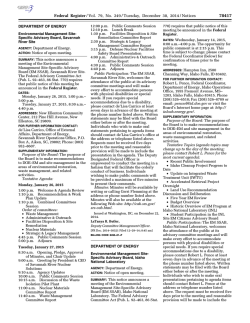
feedback - AmeriSurv.com
THOUGHTS FROM OUR READERS feedback NCEES Model Law Chad and Linda respond I read with great interest your editorial and comments concerning Chad and Linda Erickson’s article on an Idaho initiative to redefine the definition of surveying in Idaho state statutes. I am not familiar with the specifics of what is being proposed and will leave it to others to decide the efficacy of the Idaho proposal. However, your editorial seems to suggest that the NCEES Model Law definition of the practice of professional surveying has been recently modified and the Idaho effort is a result of this change. Nothing has changed in this regard. The language of the 2014 Model Law for the definition of the practice of surveying is virtually unchanged from several earlier versions. I have attached the 2014 and 2007 definitions to this email. As you can see, except for some minor editing, they are the same. The Model Law has always been open to interpretation by state boards that have always been free to accept or reject, in whole or in part, the language contained therein. This is not a new development. If there is a culprit here it’s not the Model Law or NCEES but rather what parts of it are being referenced and how it is being interpreted. Any initiative in Idaho pertains to Idaho only. As you know, each state boards of licensure along with their legislatures control the statutory definition of the practice of surveying. While I do not speak on their behalf, I know of no national effort on the part of NCEES (or NSPS for that matter) to influence state boards in this regards. While it is true that NCEES has created a special task force to examine the reasons for the falling number of applicants for the Fundamentals of Surveying Exam, any recommendations of this task force have yet to manifest themselves in actual policy and would not do so until presented for adoption at the NCEES 2015 Annual Meeting this August in Williamsburg, VA. I suspect that many possibilities and remedies will be considered by the task force for final consideration by the delegates. Glen Thurow Albuquerque, New Mexico Thanks Glen, if it wasn’t for you we would not have known of the direct connection between Idaho and NCEES, the smoking gun if you will. Idaho’ proposed legislation is nearly verbatim with the NCEES model law, including the use of the term any one or more of the following. Here are some discussion points. 1. Anyone measuring things above, below or on the earth will now be performing Land Surveys. 2. Considering the tone of the courts in the last ten years this law will never survive court challenges. 3. Therefore the legislation must have enough exceptions so no one files a complaint. Idaho’s exceptions (NCEES Model?) are so broad as to exclude everything that was newly embraced in the Model Law. A non-licensed practitioner will be immune except for land boundary activity. So what has changed besides everything is now Land Surveying? Something must have changed or why the nationwide effort? 4. At some point after the proposed legislation is adopted a State board must determine experience requirements for licensure. In Idaho the Executive Director made it very clear that boundary experience would no longer be emphasized, and used this as a main selling point. 5. Necessity, reason and the ire of the old land surveyors will demand that the four year requirement for boundary experience be retained, and let us suppose that the board caves in and attempts to do so. Will not the wording, “any one or more of the following” be grounds for a court challenge by some snot nosed kid whose application was turned down because he had NO boundary experience but was a GIS wiz? And what will the courts determine NCEES’s “any one or more of the following” to mean? I think that it is pretty obvious. 6. We should pass the law to find out what is in it? 7. NSPS and NCEES’s “We are not aware of any effort to remove boundary experience from licensure requirements” is a non-denial denial. We’re right on target. Chad & Linda Racism, prejudiced reporting, and stereotyping in your content I’m not easily shocked or offended; but, your “Fox is Guarding the Hen-house” article in the November/December issue uses racist, prejudicial and offensive language in its imaginary reference to, “He was Pakistani and couldn’t speak English.” This surely is not the norm, and any valid points the authors were trying to make are lost to the reader. Aside from the fact that the article is written in an imaginary scenario, the poor writing is full of narcissistic and ego filled “what if” rants. I love the note that states, “This cross exam was vetted by our attorney.” Really? They had an actual attorney “Vet” this garbage? This is pure immaturity and inexperience on all fronts of your publication. Needless to say, race based stereotypes are not acceptable in any professional publication, nor are flights of imaginary fancy. I will be posting my views of this publication’s actions on Social Media, sharing this fictional rant with any professionals that will listen. Hopefully this poor choice of writers makes your firm reconsider its fundamental views and consider reporting facts rather than narrative fiction. Please, never send me any of your magazines again. Ryan Wilcox Merrimac, Massachusetts Erickson responds: 1. Actually, in the past I have employed a graduate from the Land Survey School in the Idaho State University, and it was he who told me the head professor Displayed with permission • The American Surveyor • February 2015 • Copyright 2015 Cheves Media • www.Amerisurv.com feedback was from the India Subcontinent (with a PhD in math) and spoke of the other details, specifically that the students had a hard time understanding him and the prohibition of taking the instruments outside. 2. If one dialog in the article appears to be by someone from the south, that’s because she was from the south. Which is rare for Idaho, however my mother was from Orange County, Texas and I love to hear that mother tongue. 3. I’m shocked, shocked I say, that you doubt that I had our attorney vet the cross exam. Why would you write that? You wouldn’t know one way or the other. Actually, I did just as I wrote, I always do. 4. It doesn’t matter to me where the professor was from but it is a scandal to our profession for our graduating surveyors to have spent so much for tuition and not have understood the lectures. It’s counter-productive to mix the foreign language requirement with the core element, don’t you think? From what I have heard this situation is common in other universities as well. One of the weaknesses, and beauty, of the human language is that any one statement can have multiple meanings. However, in this case the intended message would have been clearer if the interrogation had read; “The professor could not speak English very well.” Your letters also might better be reduced as, “Chad Erickson, are you a racist.” The answer is “No.” I don’t care about the race, color or national origins of anyone. On the same note, I don’t care for racial activism either; it is simply another form of racism. Would a Mexican mind being called a Mexican rather than “Hispanic”? Not the ones that I know and am friends with. Would a Pakistani mind being called a Pakistani? I don’t think so. Which leaves the original intent of the article: The leaders of our profession rob the students by furnishing them primary professors who cannot speak English well enough to be understood. In attacking the messenger you have not addressed the main message of the article. What do you think of boundary experience being removed from licensure requirements? Chad Erickson More Erickson Feedback It is always good to read your articles as they are a beacon in exposing the trends that are enveloping the land surveying profession. You may have heard the story about Gloria, (http://www.sdspls.org/docs/ BSFS_2013_3_Aug.pdf, page 21) who was testifying in a boundary dispute, when asked of her opinion of the surveying profession said, “surveyors are frustrated college kids with substitute toys.” Many times I think of Delilah when she would tell Samson, “Up Samson, the Philistines be upon thee.” Looking forward to your next article and wishing you all with much success, Dwight Crutchfield, RLS Tennessee Civil Engineer Places Two-Million Dollar Home on Wrong Lot As a civil engineer and land surveyor in private practice I find myself up to my hips in alligators without the time to drain the swamp, however having said that I find that I am compelled to address a few comments to the article noted above. My comments are the result of over 40 years in the land development business. Everything from a new patio cover to multimillion dollar industrial plant expansions. As you have a selected reading audience of surveyors and engineers such as me, I will respect the professionalism of this audience and make this letter to the point and as brief as possible. Anyone involved in the land development business realizes that the process is similar to the links of a chain. The larger and more complex the development, the longer the chain with more links. Any one of these links when broken will stop the continuation of the project, and until remediated will delay the project. So, Mr. Pallamary has chosen to target the one link associated with Mr. Craig Richard Carrigan, the civil engineer retained to “… prepare the site plan, paying him $ 30,000 for his engineering services.” The first point here is the scope of the services requested by the client The Four Twenty Corporation. Apparently, if I read the article correctly, Mr. Carrigan was neither retained to provide a boundary survey nor the construction staking to locate the new house in question. Accordingly, Mr. Carrigan noted on his site plan “… a note informing the viewer that the boundary lines conform to the Class III survey standards…” In addition, I note on the diagram of the Certified Site Plan, that a lot line in question is noted as “Lot Line as Deed Descriptions see notes…” Now anyone in this business knows full well that legal descriptions are and have been prepared by Attorneys, Civil Engineers, Land Surveyors, Realtors, Title Companies et al, and the quality varies from A to Z. This represents a link in the chain of events, not necessarily the first link. The second point here is that the Tentative Development Plan was submitted to the appropriate Planning Department, reviewed, and notices sent to all the surrounding property owners alerting them to the proposed development. This means that Mr. Saul Nulman, the creator, or one of the creators of the Rose Nulman Park Foundation would have received a written notice of the proposed development. These notices solicit comments from adjacent land owners, and possible notice of a public meeting when this development would be open for public comment. The third point here is that there was undoubtedly an Architect retained for the design of the new house. Yet there is no mention of interaction between the Architect, the Civil Engineer, and the Planning Department. Architects are normally concerned with the position of the house on the property, noting on the plans the multiple distances to property lines. The fourth point here is that the final Site Plan as prepared was undoubtedly reviewed by the appropriate engineering department at the county level, and yet I notice that there is no side yard distance from the proposed house to the property line. Now this information may exist on another sheet not shown in the article, but on the one in the article. The fifth point here is that whoever preformed the construction staking to locate the pad and footprint for the new house somehow accomplished this task without the benefit of a monumented property line. In addition, the contractor Displayed with permission • The American Surveyor • February 2015 • Copyright 2015 Cheves Media • www.Amerisurv.com feedback that built and compacted the pad, and probably dug the trenches for the house foundation, did not stop and verify the distances from the property lines. There may not be a compacted building pad, but a footprint nonetheless. The sixth point here is that construction inspectors will normally note the correct position of the foundation prior to pouring concrete. If there was no monumented property line to verify this position, then the process should have stopped here. Now apparently after the house was finished but “… before the completion of the transaction, the buyer commissioned Richard S. Lipsitz, a Professional Land Surveyor and the president of Waterman Engineering Company….” I find it amazing that a new buyer would somehow suspect that a two million dollar house might be built in the wrong place, but the result is as noted in the article. As a result of the atom bomb dropped from the independent survey of the property, it appears that the new house will be torn down, the ground restored to the original condition, and the careers of several people will join the concrete rubble buried in the nearest land fill. The obvious point that I am trying to make is that several people, each representing link in the chain of development had ample opportunity to break the chain and preventing this expensive faux pas from occurring, if only they had done so. The most obvious point that Mr. Pallamary seems to be making is the professional jealously exhibited by him balling up his fists and swinging wild haymakers at the civil engineering profession. “They are civil engineering errors and clearly, Civil Engineers have no business conducting boundary line surveys.” Again, I note that it appears that Mr. Carrigan did not conduct a boundary line survey. I believe that a recent article in a professional magazine noted that in the State of California 60% of all survey work is done by civil engineers. This percentage is declining as the engineers retire and die off, but surely Mr. Pallamary is aware of this fact as he is registered in California. Did Mr. Pallamary make his point? Well maybe yes, as everyone can read the article prepared by him in your magazine. Surely there will be those that agree with his point of view no matter how slanted, as throwing haymakers at the civil engineering profession seems to appeal to surveyors. For what it is worth, I was a Land Surveyor for 13 years registered in California and 3 other states before becoming a civil engineer. B.J. Tucker, PE, PS Inyokern, California Pallamary responds Thank you for your recent letter in response to my article about the mishap in Rhode Island. With all due respect, it appears as if you may have made a few assumptions and if you will indulge me, I would like to address these conjectures. First and foremost, my article was not intended to “target” Mr. Carrigan; the Supreme Court of Rhode Island made that decision and it is evident everyone had their proverbial day in court. Whatever needed to be said is reflected in the associated legal proceedings. With regards to Mr. Carrigan’s decision to perform a Class III survey, that is clearly a matter between him and his client and I do not believe I am qualified to opine on the merits or demerits of that private business decision. What I do know is a two-million dollar house was placed on the wrong lot and that does not happen every day. As a forensic land surveyor and as a member of the profession, I believe there are lessons to be learned from mistakes like this. A two-million dollar home on the wrong lot is a problem. Your belief that “anyone in this business” knows that legal descriptions are prepared by “Attorneys, Civil Engineers, Land Surveyors, Realtors, Title Companies et al” would appear to fly in the face of many laws that govern the creation and division of real property. Whether or not there was a defect, patent, latent, or otherwise with the description of this property is speculative and to my knowledge, there were no problems with regards to interpreting the four corners of the deed. It appears as if the property was laid out using what I and my associates call the “two point tango.” In these instances, after the deed is calculated, it is laid out using a minimum amount of control, i.e. two points. I would also respectfully disagree with the notion that everyone is notified about pending development. It has been my experience that unless the permits you are referring to are not discretionary, no notification is issued. Notwithstanding that assumption, given the fact that the adjacent land was undeveloped, a problem like this could easily have gone on undetected. Indeed if there were some adjacent improvements, this problem may have been detected. Moreover and assuming that notice was issued, what bearing does that have on this problem? A licensed individual prepared a certified set of plans and it has been my experience that once that is done, most people accept those conclusions. To be sure, that appears to be the case here, does it not? I agree with you that I did not mention any interaction between the Architect, Civil Engineer and Planning Department. I saw no significant mention of that dynamic in any of the court documents nor did I see that discussed in any of the news reports I read. Assuming that such an exchange occurred, so what? A licensed individual prepared a set of plans indicating the house was in the correct location when in fact, a two-million dollar house was placed on the wrong lot. With regards to the actions taken by the contractor and others, I am unable to speak to that issue. I suspect that the foundation was laid out by either a land surveyor or a civil engineer as is the normal course of action and if that individual thought they were on the proper lot, the resultant layout is academic. It is not uncommon for this to happen. Like you I have been involved in the land surveying profession for more than 40 years and unless questions arise or if the proposed development is in a densely populated area or near an adjacent structure, building inspectors do not “normally” note the “correct” location of the building. What they typically do is rely on the opinion of the professional licensee in charge of the project. That is why licenses are issued. I am not certain as to the notion of atom bombs dropping but what I can tell you is I normally work on homes with a value of five, ten, fifteen, and twenty million dollars on a regular basis. I am regularly engaged to perform due diligence inspections on many of these homes along with other commercial structures. Most recently, I performed a detailed ALTA survey on an oceanfront hotel on behalf of an East Coast lender. As you may be aware, an ALTA survey is commissioned for this very reason—to verify that things are where they are supposed to be. Would your opinion be different if Mr. Lipsitz conducted an ALTA survey? continued on page 54 Displayed with permission • The American Surveyor • February 2015 • Copyright 2015 Cheves Media • www.Amerisurv.com feedback adindex Advanced Geodetic Surveys www.agsgps.com Feedback, continued from page 51 52 Advanced Graphics Technology www.agtcad.com 3, 52 Berntsen www.berntsen.com 35 Cadastral Consulting www.cadcon.com 52 Champion Instruments www.championinstrument.com 5 CHC Navigation www.chcnav.com 53 Certified Survey Technician www.nsps.us.com 35 Dunham & Morrow www.magneticlocator.com 39 Curt Brown Chronicles www.amazon.com 10 Eastern Drafting [email protected] 6 FARO www.faro.com/focus IBC iGage Mapping Corp www.x90gps.com 53 JAVAD www.javad.com 33-40 (Wingfold) Leica portal.leica.us/HxGN/Plans 21 Microsurvey www.microsurvey.com 11 Ocean Science www.oceanscience.com 53 Optech www.optech.com 9 Pacific Crest www.pacificcrest.com 34 Seiler solutions.seilerinst.com 53 Sokkia www.sokkia.com BC SPAR International www.sparpointgroup.com 19 Surv-Kap www.Surv-Kap.com 39 Topcon www.topconpositioning.com Traverse PC www.traversepc.com As to your belief and opinion that “the most obvious point” I am trying to make is to swing a “wild haymaker” at the civil engineering profession is a decidedly peculiar comment. As you are aware, civil engineers are prohibited from performing surveys in California and have been since 1983. That is largely due to that fact that they did not know what they were doing. That is not my opinion—it is the learned opinion of the state legislature. When I prepared my article, I spoke to a lot of people, many of whom are from Rhode Island and the undisputed consensus was, and remains, this error was created by a civil engineer. As much as I might like to alter the facts, they are what they are and giving the fact that the Rhode Island Supreme Court vetted this case and issued its rulings, I suspect that all parties weighed in accordingly. At the end of the day, a civil engineer is responsible for a two-million dollar house being placed in the wrong lot and that is a finding of the court. As to your perceived impression of bias on my part, I stand behind my thesis. Civil engineers have no business performing boundary surveys no matter how competent they are moving numbers around. To quote the late Curtis M. Brown from some fifty years ago: The civil engineers wish to have all the privileges and rights of the licensed land surveyor, yet too frequently they do not recognize the responsibility of educating themselves for the duties involved . . . It is a historical fact that the civil engineering approach has never, during more than 50 years of experience with land surveyor registration laws, provided enough civil engineers who were simultaneously qualified and interested enough in survey engineering to satisfy the needs of land surveying. IFC-1 7 Trimble www.trimble.com 23 VR Mesh www.vrmesh.com 52 Again, thank you for taking the time to reply to my article. Mike Pallamary Got some feedback? Contact us via www.amerisurv.com, or send a letter to: The American Surveyor, P.O. Box 4162, Frederick, MD 21705-4162. ◾ Displayed with permission • The American Surveyor • February 2015 • Copyright 2015 Cheves Media • www.Amerisurv.com
© Copyright 2025








